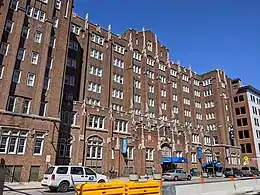Social services and homelessness in Columbus, Ohio
Columbus, the capital city of Ohio, has a history of social services to provide for low- and no-income residents. The city has many neighborhoods below the poverty line, and has experienced a rise in homelessness in recent decades. Social services include cash- and housing-related assistance, case management, treatment for mental health and substance abuse, and legal and budget/credit assistance.

History
|
Annual point-in-time count of homeless in Columbus and Franklin County | |
Transitional housing Sheltered Unsheltered Source: Community Shelter Board[1] | |
Redevelopment and gentrification has displaced low income and homeless residents of Franklinton, the Short North, and other neighborhoods in Columbus. Redevelopments in 1997 displaced homeless residents of the Scioto Peninsula, and forced the closure of a shelter and relocation of another. The nonprofit Community Shelter Board established the Scioto Peninsula Relocation Task Force to find stable housing and support services for these displaced residents.[2]
Although national homeless rates for families declined by about 32 percent in the 2010s, Columbus experienced an increase of 20 percent. In 2019, the area shelter system reached its highest-ever occupancy rate, with 570 people served. The Columbus Dispatch attributed the rise to increasing rents outpacing wages, low vacancies allowing landlords to be selective, the city's growing population, low funding for re-housing, and limited affordable housing options.[3] In 2018, emergency shelters in the county served about 9,200 adults and children, and a one-night count in January 2019 estimated 1,907 people either in shelters or on the streets. In 2019, the Dispatch reported on the city's policy of dismantling homeless camps, displacing its residents without a plan to re-house them.[4] The city recognized problems in some of the camps, including the danger of propane tanks across the area, as well as a murder taking place in one of the camps in April 2016.[5]
Homeless shelters and support
Shelters

Homeless shelters include the YWCA Family Center, Faith Mission's Emergency Shelter for Men, Rebecca's Place Women's Homeless Shelter, the Open Shelter, Friends of the Homeless Men's Shelter, Haven of Hope House, and Huckleberry House Emergency Overnight Shelter.[6] The YMCA of Central Ohio also provides shelter to the homeless and those at risk of homelessness. The organization maintains three shelters: the Downtown YMCA, Franklin Station, and the Van Buren Center.[7] In March 2020, amid the COVID-19 pandemic, the Community Shelter Board and YMCA together created a new homeless shelter for those who have symptoms or test positive for COVID-19.[8] The shelter, known as the Shelter for Isolation and Quarantine, is in a North Side hotel. At its peak, the shelter housed 39 people.[9]
Columbus is one of only about six places in the United States that guarantee a right to shelter for families. The list also includes New York City, the state of Massachusetts, and Washington, D.C. (though only during hypothermic or hyperthermic conditions).[10]
Prevention initiatives
The Community Shelter Board began its homelessness prevention initiative in the late 1980s in response to growing demands for emergency shelter. The organization collaborates with government, corporate, nonprofit, and philanthropic organizations to pool resources together. It determines individuals eligible by having a household income of 50 percent or lower than the Area Median Income, by having a steady and verifiable income, with housing costs of 50 percent or less of the family income, or 45 percent or less of the individual's income. The requirements are high enough that it can result in shelters being unduly used by individuals with significant economic, social, or psychological obstacles.[11]
For homelessness prevention, the Community Shelter Board offers cash assistance (e.g. for rent, food, utilities, gasoline), housing-related assistance (e.g. maintenance, search support, relocation, mortgage assistance), case management (for employment or support with mental health or in domestic violence or substance abuse), offers treatment for mental health and substance abuse, and offers legal and budget/credit assistance.[11]
Since 2008, the Columbus Coalition for the Homeless has produced Street Speech, the only street newspaper in the city. The paper is sold and written by and for those experiencing or who were once experiencing homelessness. The vendors are vetted, trained, and licensed to dispense the papers. The newspaper raises awareness about homelessness, brings in revenue for the street vendors, and provides useful information for those in need. All earnings are donations kept by the vendor.[12][13]
Other services
Since 1999, the Engagement Center at Maryhaven has treated people with drug and alcohol dependencies through its emergency shelter. The center also established 50 beds for crisis stabilization services. Maryhaven replaced several functions of the Open Shelter, which closed in 2004.[14]
References
- https://66381bb28b9f956a91e2-e08000a6fb874088c6b1d3b8bebbb337.ssl.cf2.rackcdn.com/file-2019-Count-results.pdf
- https://66381bb28b9f956a91e2-e08000a6fb874088c6b1d3b8bebbb337.ssl.cf2.rackcdn.com/files-Rebuilding-Lives-A-Description-of-Implementation-Processes-Successes-and-Challenges-and-Recommendations-for-the-Future.pdf
- Price, Rita. "Columbus families struggle to overcome homelessness". The Columbus Dispatch.
- Price, Rita. "Homeless struggle after makeshift camps demolished". The Columbus Dispatch.
- Namigadde, Adora. "Columbus Is Clearing Homeless Camps, But Housing Efforts Are Slow To Take Off". radio.wosu.org.
- "Columbus Ohio Homeless Shelter List". www.shelterlist.com.
- "Housing & Supportive Services". ymcacolumbus.org.
- Wynn, Sarah (March 31, 2020). "New shelter announced for Columbus homeless population with coronavirus". WSYX.
- Downing, Andy. "Shelter from the storm: Providing care, comfort for homeless impacted by the coronavirus". Columbus Alive.
- Leopold, Josh (January 14, 2014). "How homelessness continues to decline despite the affordable housing crisis". Urban Institute.
- https://www.issuelab.org/resources/6627/6627.pdf
- https://www.dispatch.com/story/news/local/2020/08/14/street-newspaper-vendors-try-to-hang-on-until-downtown-workers-events-return/42208939/
- https://www.10tv.com/article/news/city-attorney-teaming-newspaper-helps-homeless-find-fugitives/530-7233b1ce-4b99-4acd-83a7-55ada235ee3f
- https://66381bb28b9f956a91e2-e08000a6fb874088c6b1d3b8bebbb337.ssl.cf2.rackcdn.com/files-Rebuilding-Lives-A-Description-of-Implementation-Processes-Successes-and-Challenges-and-Recommendations-for-the-Future.pdf
